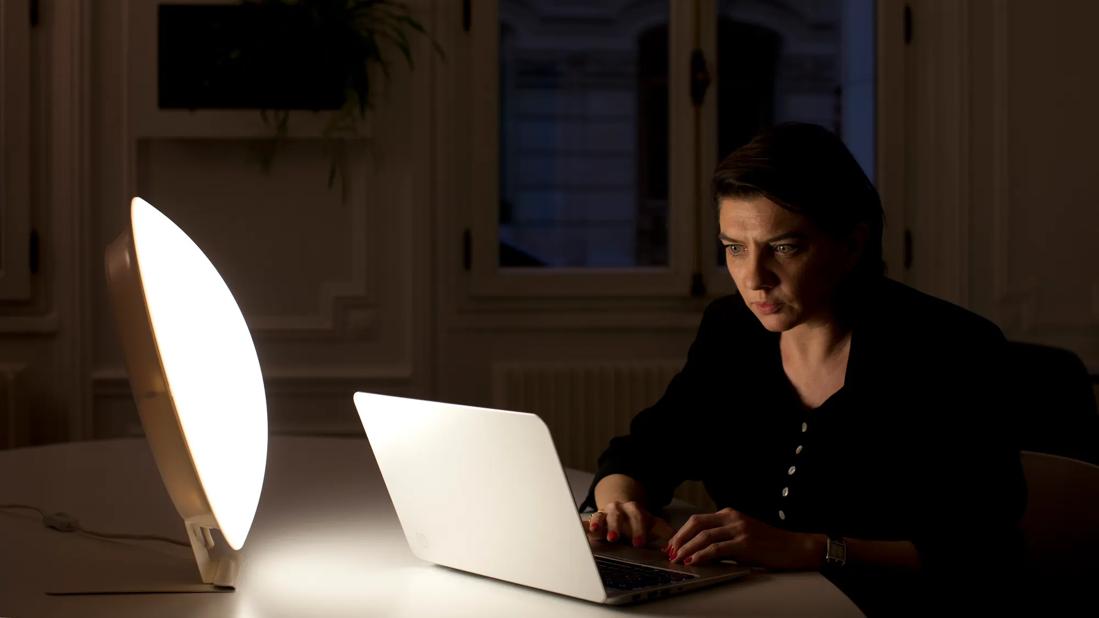Sitting near a light box for about half an hour a day can help treat this form of fall/winter depression

The winter months may mean snowball fights, hot cocoa and holiday decorations, but they also mean less sunlight. And less sunlight can lead to seasonal affective disorder (SAD), which is now known as a major depressive disorder with a seasonal pattern.
Advertisement
Cleveland Clinic is a non-profit academic medical center. Advertising on our site helps support our mission. We do not endorse non-Cleveland Clinic products or services. Policy
SAD is a form of depression that typically happens in the fall or winter. The lack of sunshine can affect your circadian rhythm, or your body’s internal clock, and throw your serotonin and melatonin levels out of balance. All of this can play a role in your sleep patterns and mood, making winter feel gloomy, both internally and externally.
Enter light therapy, which simulates sunlight to help treat SAD and other conditions like depression and sleep disorders. Psychologist Adam Borland, PsyD, talks about the science behind light therapy and how you can use it at home.
Light therapy, also known as phototherapy or bright light therapy, uses artificial light to help treat SAD and other conditions that are associated with it. To use light therapy, you need to sit or work near a light therapy box for about 30 minutes.
“Especially in the winter, our bodies react to the gray, cold weather and lack of natural sunlight,” says Dr. Borland. “What light therapy does is compensate for the lack of exposure that we get from natural sunlight.”
There are light therapy options like dawn stimulators and natural spectrum light bulbs, but using a light box — a lamp-like device with a flat screen that uses full-spectrum fluorescent light — is most common in treating SAD.
Advertisement
“Look for one that gives an output of 2,500 to 10,000 lux, which is a way to measure light brightness,” Dr. Borland advises.
As you’re shopping for your light box, it’s worth noting that there are also specific colors of light therapy, like blue or red light therapy for skin health or green light therapy for migraines. But light boxes or other light therapy devices for treating SAD use a full-spectrum fluorescent light.
Light therapy is considered the best treatment for SAD, combating some of the effects of winter darkness by helping your circadian rhythm and balancing your serotonin levels, as well as:
In other words, yes, light therapy works for SAD, and it can help with SAD-adjacent concerns, too. But there’s a catch: Light therapy isn’t a one-and-done.
“To get the most effective and longest-lasting boost in your alertness, mood, energy and concentration, it’s important to use light therapy regularly,” Dr. Borland advises.
If you’re interested in using a light box, there are plenty of options available for purchase. With its affordable price point and small, convenient size, using a light box can be a great way to address your seasonal affective disorder.
Dr. Borland says that while the amount of time you need to use your light box differs for everyone, most people use it for 20 to 30 minutes a day.
Be sure to read the manufacturer’s safety instructions for your device before getting started. But for the most part, here is the best way to use a light therapy lamp:
Advertisement
“Go in with an open mind,” Dr. Borland urges. “This is something that can be used in addition to medication, talk therapy, exercise and socializing — all of these things that are important in life.”
Dr. Borland cautions that you should talk to your healthcare provider before starting light therapy. It might not be a safe option if you:
Light therapy is usually considered safe and has few side effects, but some people experience:
If you notice these symptoms while using light therapy, stop using your light therapy device and contact your healthcare provider.
Advertisement
Learn more about our editorial process.
Advertisement

Alcohol is a depressant and can interfere with your sleep, mood and more

Major life events and trying times can trigger reactive depression symptoms, like prolonged sadness, irritability and hopelessness

Slight increases are somewhat common from either the medication or changed habits

Some medications may result in a few lost pounds, but weight gain is far more common

The medications target different chemicals in your brain to improve mood

Both medications are first-line treatments for depression and other mood disorders

Light therapy can boost sleep and help fight depression

People with high-functioning depression may not seem depressed on the outside, but the condition can cause turmoil on the inside

The best parenting style balances enforcing rules and showing plenty of love

Tips include cutting back on sugar, focusing on exercise and managing stress

It can be harder to let go when you’ve invested time, energy and emotions — but it might be the healthier choice long term